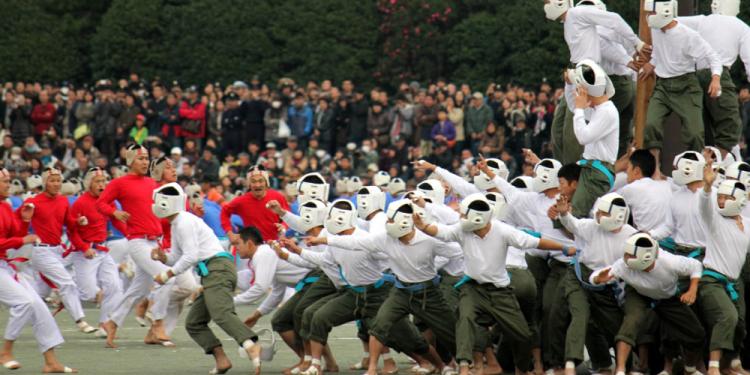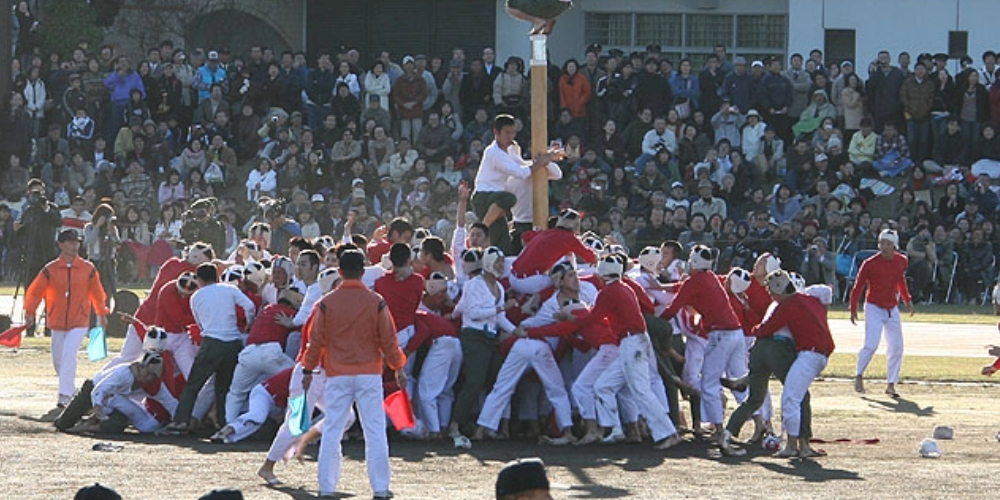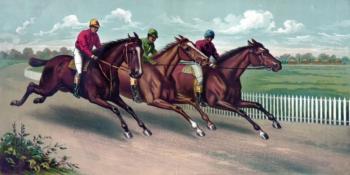Everything You’ve Ever Wanted To Know About Bo-Taoshi
Posted: January 9, 2024
Updated: January 9, 2024
Bo-taoshi" is a traditional Japanese sport played by two teams. It involves a large pole, typically about 10 meters tall, with a smaller pole or banner attached to the top. Each team consists of 150 players, with positions like attackers and defenders. The purpose of the game is to bring down the opposing team's pole.

A noisy and lively spectacle witnessed by thousands of onlookers—parents, teachers, and proud alumni – sees a frenzy of youthful students charged across the field on a bright spring day. Their collective roar filled the air as they collided head-on with a formidable human barricade, staunchly defending an imposing 11.8-foot wooden pole. Chaos ensued as the attackers clawed, shoved, and vaulted over their opposition. It was a tumult of energy reminiscent of a stormy sea, with bodies colliding, heads bumping, and elbows flying.
Despite the fervent assault, the wall held its ground, resilient and unwavering, while the pole teetered but ultimately remained standing. This wasn’t just a game; it was Bo-Taoshi—a century-old amalgamation of American football, rugby, sumo, and martial arts. Its intensity and risks have led many Japanese schools to forsake it, yet at Kaisei Gakuen, it thrives as the highlight of the school’s yearly sports festival.
Bo-Taoshi – A Japanese Staple
In the realm of American sports, Bo-Taoshi remains a hidden gem—a cherished tradition at Kaisei, an illustrious secondary school established in 1871. Educators extol the virtues of the game, citing its ability to foster teamwork, resilience, and good sportsmanship. For students at Kaisei, the tournament in their junior and senior years is eagerly anticipated, marking a pivotal moment in their school experience. Underclassmen engage in less complex games, while alumni fondly recall intricate details of Bo-Taoshi matches played decades ago.
Bo-Taoshi – It’s Nothing But Pure Mayhem
To the uninitiated eye, Bo-Taoshi appears as a whirlwind of disorder. On one end of the field, two dozen attackers strive to topple a pole while an equal number of defenders aim to keep it steadfast. Simultaneously, a mirror image of this unfolds at the opposite end of the field, with attackers and defenders on opposing sides from their earlier positions, engaged in the same mission.
The first Bo-Taoshi team to lower the pole’s tip below 140 centimetres within 90 seconds claims victory, initiating a restart if neither team achieves this feat. In case of a second draw, chance intervenes through a lottery to break the tie. At Kaisei, spirited chants like “Fight to the finish!” and “Win at all costs!” echo as players, adorned with vibrant headbands, rally each other.

Despite donning minimal protective gear—soft helmets, knee pads, and athletic cups—the Bo-Taoshi players embrace a culture where sprains, cuts, and bloody noses are commonplace and deemed acceptable. Occasionally, more severe injuries such as fractured bones, concussions, and facial injuries occur, a trend that has seen a worrying rise in recent times. School records, up until 2016, highlight a staggering 52 percent surge in injuries from 2005. Tetsuo Shimizu, a veteran maths teacher at the school and a festival spokesperson, attributes this increase not solely to enhanced reporting but also to a divergence between athletically inclined students and a growing cohort engaged in other pursuits but still participating in Bo-Taoshi.
Head to Head Fighting
Bo-Taoshi has been a pivotal part of Kaisei’s sports festival since 1929, tracing its origins to even earlier times. According to Minoru Matsunami, a sports historian at Tokai University, Bo-Taoshi possibly amalgamated various popular recreational games of the 1890s. These included Sao Nobori (pole climbing), Hata Tori (capture the flag), and Tsuna Nobori Hata Tori (scaling a rope and seizing a piece of cloth). Another theory suggests its resemblance to a version of capture the flag called Taisho Tori, wherein a flag crowned a pole.
This version potentially originated among students in Kagoshima, southern Japan, potentially finding its way to the naval academy in Hiroshima Prefecture and evolving into the Botaoshi played at the National Defense Academy. According to online gambling news in the US, in bygone years, conditions were notably harsher. At Kaisei, games often endured for about five minutes, with tied matches triggering endless replays that stretched tournaments late into the night. Students donned minimal protective gear while the rules were condensed onto a few pages. “We didn’t strategize like in American football,” recalled Akito Hattori, a 1977 graduate who, as a defender in Bo-Taoshi, broke his clavicle.
“It was more primal and unstructured.” His close friend from that era, Shin Sone, an attacker in Bo-Taoshi, described it more bluntly as “a direct clash.” We should point out that the Bo-Taoshi variant at the defence academy assumes a more aggressive stance: defenders stand atop their teammates’ shoulders, with one defender perched on the pole kicking attackers.
Parental Concerns With The Game’s Violence
However, by the 1980s, parental concerns veered towards prioritising college entrance exams, leading to apprehensions about the safety of physical games like Bo-Taoshi, Kumitaiso (human pyramid building), and Kibasen (mock cavalry battles or chicken fights). Consequently, schools began phasing them out of their festivals.
Notably, three years ago, at Azabu Gakuen, another esteemed all-boys school in Tokyo, an incident saw a Bo-Taoshi student taken to a hospital in an ambulance due to a forceful impact during Bo-Taoshi. Although the student didn’t sustain a feared spinal injury, the school opted to discontinue the game. “Some teachers worried that the game might have crossed a threshold,” shared Hideaki Taira, the school’s headmaster.
Bo-Taoshi – Months of Strategy for 90 Seconds of Battle
Unlike the approach in many Japanese schools, Kaisei grants students substantial autonomy in orchestrating their sports festival. For months preceding the event, they meticulously plan its logistics, fine-tune game regulations, and strategize for success. The Bo-Taoshi festival’s rule book spans 124 pages, densely packed in a diminutive Japanese font. “The teachers trust us and allow us considerable freedom,” remarked Sotaro Yokoi, a junior and a chief umpire, while also noting that teacher intervention is swift if any serious injuries occur during the games.

Bo-Taoshi, on the surface, seems straightforward, yet Kaisei students invest extensive time in strategic plotting. Attackers are organised into three primary groups. The initial cohort, comprising roughly six members, aims to forge a path towards the pole by pushing aside defenders. A subsequent wave vaults over defenders to seize the pole, while the third group endeavours to disrupt defenders and lower the pole by pulling the legs of their teammates clinging to it. This group also thwarts defenders attempting to hinder their teammates.
The Bo-Taoshi Game Begins In Earnest
Moments before the Bo-Taoshi game commences with the shrill blow of the whistle, the first wave of attackers advances towards midfield in a tightly packed formation, concealing the identity of the leader of the charge. Typically, this group consists of taller students with a higher likelihood of grasping the pole. Meanwhile, Bo-Taoshi defenders assemble in concentric circles.
An inner ring of three defenders staunchly grips the pole, while another trio secures its base. Eight defenders form a secondary layer, crouching with backs turned toward the inner ring, interlocking arms for stability. The remaining defenders extend into a broader circle, prepared to repel or pull down any attackers aiming for the pole.
Strategic deliberations largely revolve around determining the number of attackers to deploy and their patterns of assault. While some teams favour a direct frontal approach, others adopt diverse points of attack around the pole. Practices are meticulously recorded on video, safeguarding the secrecy of strategies that are then passed down to underclassmen.
Like Two Seperate Games Played At Once
An intriguing aspect of Bo-Taoshi lies in the attackers’ and defenders’ lack of awareness regarding their counterparts’ progress at the opposite end of the field. “We focus on executing our plan flawlessly. During the 90-second Bo-Taoshi game, it’s all about action rather than contemplation,” explained Masato Takubo, a senior and captain of one of the teams. Divided into eight colour-named teams, students aim to secure three consecutive match victories for overall triumph.
This year, the atmosphere buzzed with excitement. Alumni, affectionately dubbed “old boys,” congregated near the grandstands, reminiscing about their own playing days. Parents fervently cheered on their sons, while underclassmen, rallied by cheerleaders, chanted spirited fight songs. The crescendo of sound intensified as Bo-Taoshi attackers strained to pull down the pole and defenders countered, leveraging their shoulders to maintain its elevation. Gasps punctuated the air as attackers soared over defenders in attempts to reach the pole, met by further cheers as defenders swiftly yanked them away.
As the final Bo-Taoshi match concluded, time expired before the yellow and purple teams could topple the pole. Judges meticulously measured the distance of the poles from the ground, declaring the yellow team as the victor. With the championship secured, the jubilant winners tossed their helmets skyward and embarked on a celebratory victory lap.
Summing Up – Bo-Taoshi Betting
After searching through all the best online sportsbooks in the US, we couldn’t find any that list Bot-Taoshi on their books. However, if you’re looking to take a punt on any sporting events, here at Gamingzion.com, we strongly recommend Bet365 Sportsbook. They offer thousands of varied betting markets, including Japanese Pachinko, along with some great odds and bonuses, especially for new players who are signing up for the first time.
Click here to try the best odds at bet365 Sportsbook












